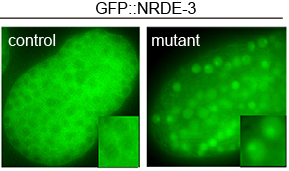


]
For a long time, small fragments of ribosomal RNA have been widely considered by the research community as non-specific degradation products and neglected as garbage sequence. Little is known about their biological processes, functions and regulatory mechanisms. GUANG's team found that a new class of antisense ribosomal siRNAs (risiRNAs) downregulate pre-rRNA through a nuclear RNAi pathway. The risiRNAs are sensitive to environmental stimuli and gene mutations. When a gene SUSI-1(ceDis3L2) is mutated, risiRNAs are dramatically increased. Interesting, this SUSI-1(ceDis3L2) mutation is also identified in a human disease called Perlman's syndrome. Therefore, this study not only discovered a new mechanism to maintain RNA steady state in cells, but also is of great significance for the treatment of human Perlman's disease.

Figure: risiRNA elicits the cytoplasm-to-nucleoli translocation of NRDE-3 to silence pre-rRNA. (Image by GUANG Shouhong)
The work is titled RdRP-synthesized antisense ribosomal siRNAs silence pre-rRNA via the nuclear RNAi pathway in the February 6 online issue of the journalNature Structure and Molecular Biology. Dr. ZHOU Xufei and FENG Xuezhu are the co-first authors. The National Science Foundation of China (NSFC) and the University of Science and Technology of China (USTC) provide finance support.
Article link: http://www.nature.com/nsmb/journal/vaop/ncurrent/full/nsmb.3376.html
 Back
Back